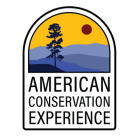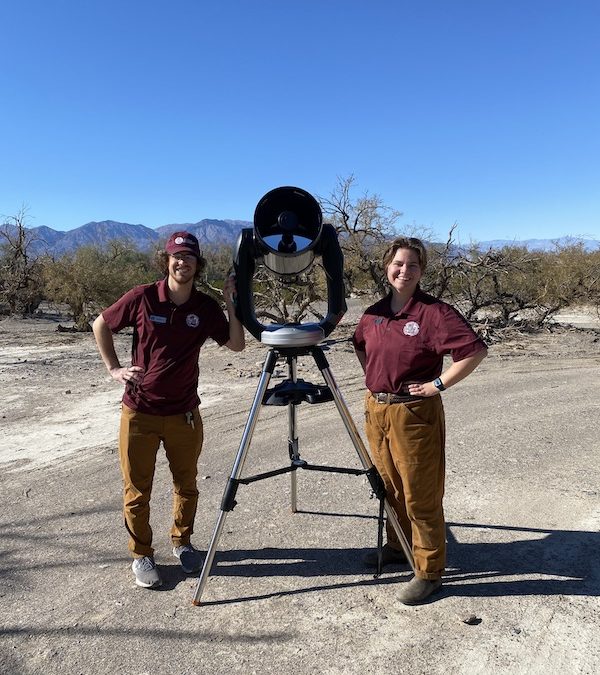Meet Han and Nathan: Night Sky Members at Death Valley National Park
Written by: Han Johnson and Nathan Spicuzza
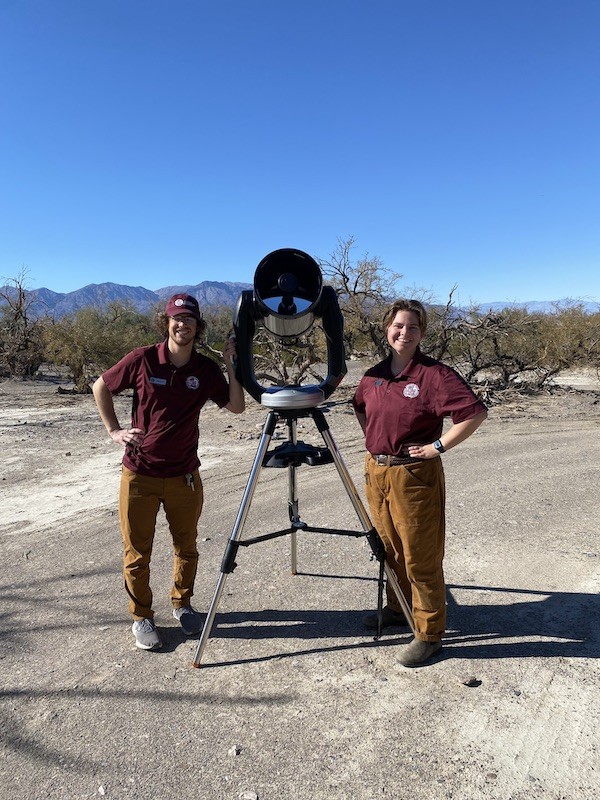
Tell us a bit about yourself and your interest in conservation.
Han: My name is Han Johnson and I use they/them pronouns. I am a HUGE fan of nature and love to spend my free time exploring our national parks. I also really enjoy reading about the desert, my favorite authors are Craig Childs and Terry Tempest Williams. My current favorite joke to tell at programs is: What is everyone’s favorite thing about the Earth? My favorite thing is the way the Earth rotates, it really makes my day! In 2018 I took my first ever trip to a national park as a break from some political work I was doing at the time. I visited Canyonlands National Park, saw a petroglyph panel called Newspaper Rock and sat there for hours wondering the who, what, why, and how of the incredible petroglyphs in front of me. I went to Arches National Park and hiked Delicate Arch in the middle of the day in 100+ degree heat. Naturally, I got a heat illness and a ranger explained what was happening and talked to me about their job as a ranger. Those two experiences made me realize that I wanted to be a ranger and help educate people about the who, what, how, and whys while protecting and exploring America’s most beautiful places.
Nathan: My name is Nathan Spicuzza (he/him), and I am 25 years old. I grew up outside of Cleveland, Ohio and spent time in Columbus and Seattle before starting jobs with the park service. I absolutely love to play board and tabletop games, often starting game nights and D&D campaigns at the parks that I work at. I have spent a lot of recent time playing and studying chess. I also spend time hiking, cooking, and looking up at the stars. I have had an affinity for the night sky since being introduced to astronomy by my mother as a child. It always was a small hobby of mine, and I am so glad to have been able to make that interest blossom, share it with the public, and teach the importance of keeping our night skies dark!
How did you begin working in interpretation?
Han: After talking to every ranger I could find, I learned that there were many pathways into the Park Service, but a pretty sure-fire path was through Americorps. I applied to work with ACE Southeast Conservation Corps and spent a summer performing trail work and building invaluable connections with the Park Service. I used those connections to learn about interpretation and became an Americorps interpretation intern at Capitol Reef National Park. During my term, I networked with everyone I could and set my focus on working in interpretation in the formal Green and Grey Park Service uniform. I ended up working at Arches National Park as a Green and Grey ranger this past summer. My biggest advice for someone trying to start working with the Park Service is to take internships, network, network, network, set focus to your goals, and take every opportunity you’re given.
Nathan: It had always been a dream of mine to be a park ranger, but I had studied and planned to be an engineer. In the middle of my masters’ studies, I got a summer job as an interpretive ranger at the Chesapeake and Ohio Canal National Historical Park in Maryland. I absolutely fell in love with interpretation, and I decided to completely change my career path to become a full-time park ranger. I finished out my degree, but right after graduation, I got another interpretive ranger position at Arches National Park, where I honed my skills and met a lot of great people. After Arches, I gained a new appreciation and skill for night sky interpretation, which lead me to this ACE position at Death Valley National Park.
What does a typical day look like for you?
Han and Nathan: There isn’t really a typical day for our team. We work a variety of shifts and schedules. Some days we’ll work in the back office – researching astronomy and accessibility or designing and 3D printing tactile models for the blind – other days we might help out at the visitor center desk, aid in search and rescues, attend different trainings on the night sky and interpretation, or – the best part of the job – we get to give astronomy programs to visitors. Some of these programs are in an auditorium setting with a power point presentation, but our favorite programs are our laser-guided sky tours which can draw crowds of up to 400 people!!
What is something you wish others knew about the Night Sky?
Han: The night sky is such an incredible resource that every culture has connected with throughout all of human history. Although only 1/10 Americans can see the Milky Way from their backyard today, there are still so many ways to connect to the sky. International Dark Sky Parks, Communities, and Places exist in every state and provide ideal stargazing opportunities. If these places are inaccessible to you, there are telescope live streams, amazing photos and videos of deep space objects, and more scientific research into the wonders of space than ever before. I hope this era of scientific connection to space can continue to spark curiosity and connection to the wonders of the universe.
Nathan: We are entering a new golden age of space exploration! New technology like the James Webb Space Telescope and NASA’s Artemis missions are giving humanity new looks at the universe that we live in and our place in it. We are refining and growing our search for extraterrestrial life, and soon, we may be returning to the moon and eventually continue on to Mars! I truely believe that this is the best time to be into astronomy since the space race of the 1960s. There is so much exciting discoveries to be made, and I hope people can get more involved.
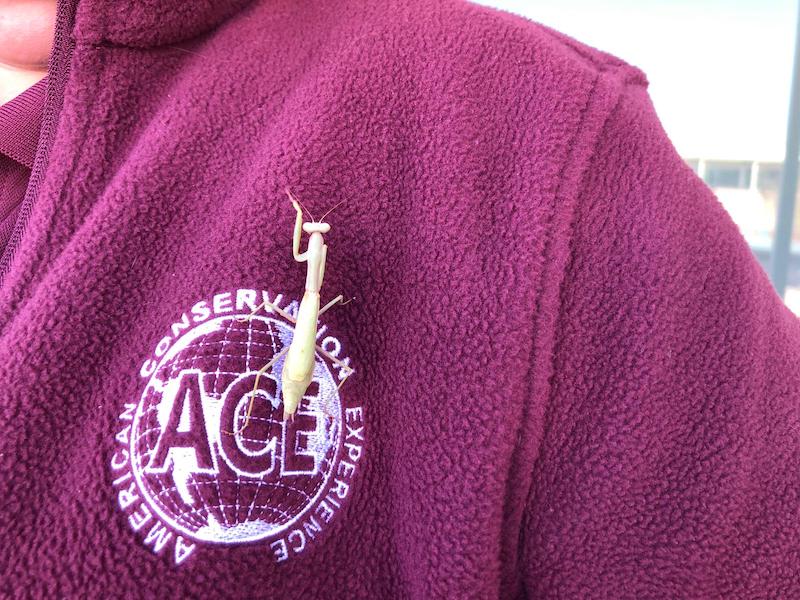
What has been a highlight of the season so far?
Han: I feel as though I’ve had so many incredible opportunities to grow as a leader and interpreter this season. Although, something that always makes me smile is the first time you shine your laser at a star during a program. The whole audience audibly gasps and typically asks for you to use the laser again. That feeling of communal awe is something I’ll never shake that always makes my day (truthfully my night) brighter.
Nathan: My highlight thus far is giving programs to hundreds of people and seeing the excitement that people have about the night sky. Being able to give visitors some knowledge to bring home with them is such a joy as an interpreter, and I have so many opportunities to do just that. It is so incredibly dark here in Death Valley that visitors will always see something new. It will never get old hearing, “This is my first time seeing the Milky Way!”
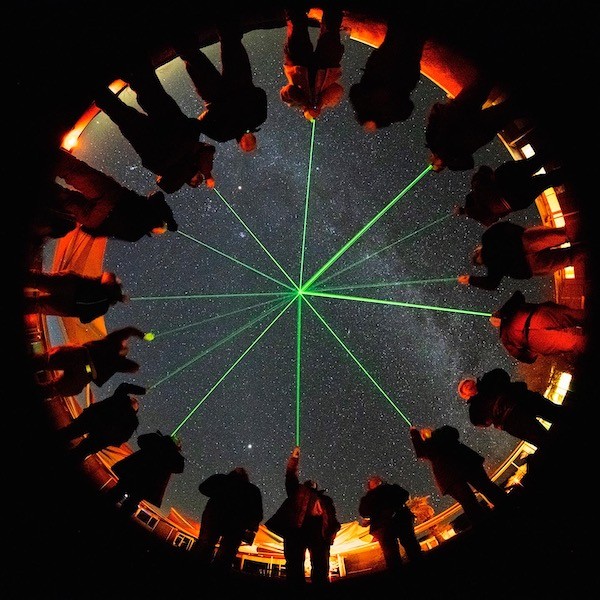
Photo credit: Mike Shaw
